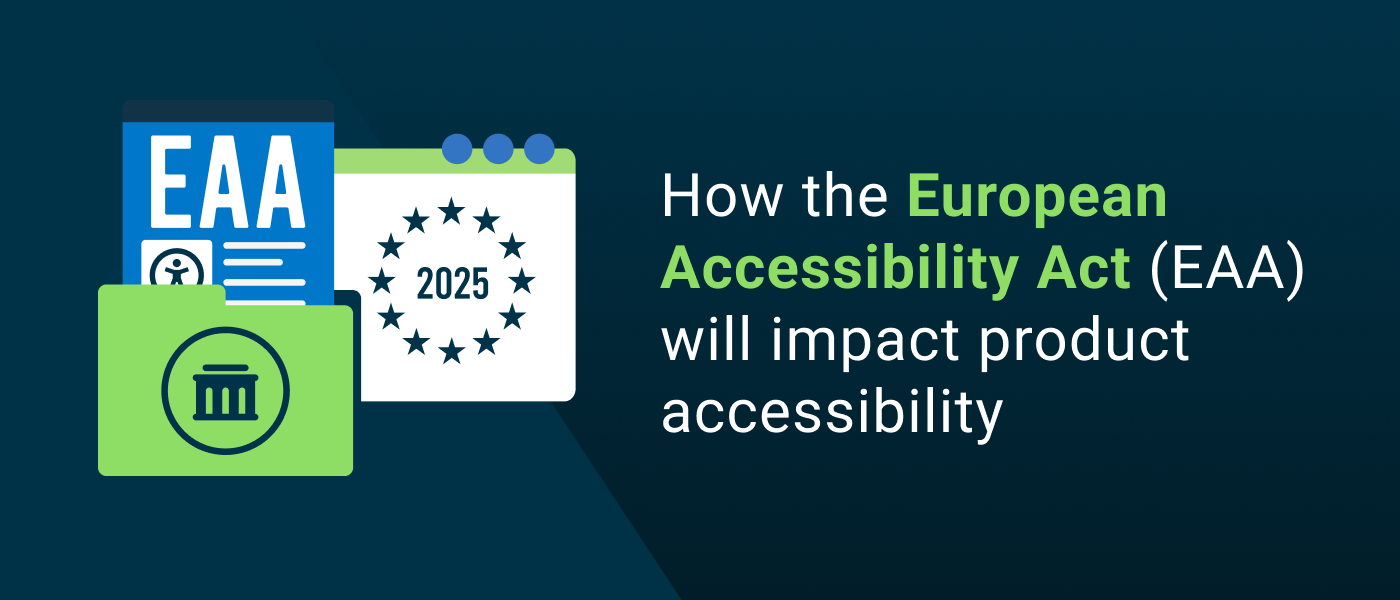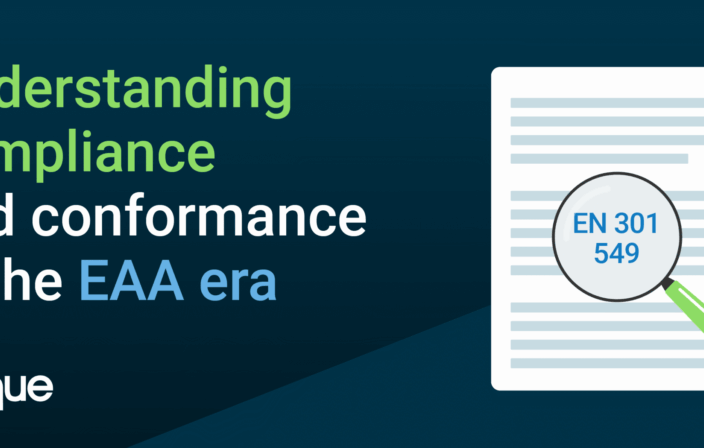Welcome to the second in a series of blog posts about the EAA dedicated to breaking down the regulatory requirements, dispelling the complexities, and promoting the positive impact of adherence. Whether you’re a business owner wanting to ensure compliance, an advocate for digital inclusivity, or someone interested in European regulations, this series will offer comprehensive insights for everyone. In each post, we will unravel a new facet of the EAA, empowering you with actionable information to effectuate positive changes in alignment with the EAA.
You can find our first post in the series here: An introduction to the European Accessibility Act (EAA)
What is the European Accessibility Act (EAA)?
The European Accessibility Act (EAA), which goes into effect on June 28, 2025, is a European Union directive that aims to make products and services in the EU more accessible for people with disabilities and other persons who experience functional limitations, such as “elderly persons, pregnant women or persons traveling with luggage.”
The EAA sets out common accessibility requirements that certain products and services must meet. These requirements cover a wide range of products and services, including media content, digital software and content, financial services, and public services. If your business provides a digital product or service to consumers within the EU, the EAA likely applies to you!
Due to the comprehensive requirements cited by the EU Member States that have so far implemented the directive, many businesses may discover a gap between the current accessibility of their product or service and compliance and the directive, with little time to remediate.
In this post, we’ll focus specifically on implications for products. Our next post will tackle services.
Products
This legislative directive applies to a diverse range of industry sectors and touches upon numerous products, distilling multiple layers of complexity. Here, we’ll delve a bit deeper into the specifics—from general-purpose computer hardware and operating systems to various self-service terminals such as payment, ticketing, and check-in machines, and consumer terminal equipment used for electronic communications and audiovisual media services, all the way to e-readers. Regardless of your industry or business model, if you deal with these categories, the EAA can have significant implications. Let’s break it down.
Computer hardware systems and operating systems
In essence, the EAA mandates that both the hardware and software of standard consumer computer equipment need to meet specified accessibility standards. Here’s a closer look at how the Act applies to standard consumer computer equipment and their operating systems.
Consumer general-purpose computer hardware systems
Devices such as smartphones, tablets, laptops, and desktop PCs are explicitly included within the scope of the EAA. The directive emphasizes that these devices, due to their multipurpose nature and common use by consumers, should be designed with accessibility in mind.
Operating systems
The operating systems for these devices, including Android, Windows, macOS, and iOS are also directly addressed by the EAA. The directive recognizes that for these computer hardware systems to function accessibly, the underlying operating systems must also be designed to be accessible.
Televisions and media players
Televisions are defined as products within the scope of the EAA-Directive (EU) 2019/882, particularly connected or smart televisions, consumer terminal equipment with interactive computing capability, connected televisions, ICT with video capabilities, and more.
Set-top boxes and media players
The EAA Directive explicitly mentions “set-top box-based applications” and “connected television services” as falling under the umbrella of “services providing access to audiovisual media services.” This means that devices like Google Chromecast or Apple TV, which act as gateways to these services, are subject to the accessibility requirements outlined in the EAA.
A focus on services
A key takeaway from the EAA is its emphasis on services rather than individual components. The directive frequently highlights the need for the accessibility of the services provided through a device, not just the device itself. For example, “access to audiovisual media services” encompasses not only the hardware and software of the media player but also the accessibility of the content being accessed.
The EAA carefully outlines other services as well, such as subtitles for the deaf and hard of hearing, audio description, spoken subtitles, sign language interpretation, electronic program guides (EPGs), and connected television services.
Finally, as you think about everything TV-related, don’t forget packaging, CE marks, remote controls, and support and warranty user flows. The directive covers these additional items in other areas of the directive.
Self-service terminals
The EAA lays out a comprehensive framework for making self-service terminals more accessible within the EU. The directive not only sets clear requirements for the products themselves but also acknowledges the operational challenges faced by service providers by providing flexibility and encouraging a balanced approach to achieving inclusivity.
Devices like payment terminals—or any device whose primary function is to enable payments using payment instruments (like debit/credit cards) at physical points of sale—are included in the scope. This applies to both the hardware and software of these terminals.
The EAA specifically lists several self-service terminals that fall under its scope when they are dedicated to providing services covered by the directive. These include:
- ATMs (Self-service banking outlets)
- Ticketing machines: This category encompasses a range of machines that issue physical tickets granting access to services.
- Check-in machines
- Interactive information-providing terminals: This category includes terminals with interactive screens intended for providing information to the user. However, it’s important to note that this excludes terminals installed as integrated parts of transportation vehicles.
E-books, e-readers, and reader software
The EAA aims to create a level playing field, allowing people with disabilities to enjoy the same digital reading experience as anyone else. The directive specifically lays out some key requirements for e-books, e-readers, and reader software to ensure digital reading material is available to everyone.
The e-book file
At the heart of the issue is the e-book file itself. The EAA stresses the importance of these files being digitally built to work with “assistive technologies.” This means things like text-to-speech software, screen readers, and similar tools should be able to easily interact with the e-book. This accessibility is crucial for people with disabilities who may rely on such technologies.
E-reader devices
The EAA makes a clear distinction between general-purpose reader software and e-readers, which are dedicated devices designed specifically for consuming e-books. These devices, including their hardware and software, are subject to specific accessibility requirements under the EAA. This means manufacturers need to consider features like display customization, text-to-speech functionality, and overall usability for people with disabilities.
E-reader software
Reader software, be it an app on your phone, a program on your computer, or even a website offering a preview of a book, falls under the scope of the EAA. These platforms need to be designed with accessibility in mind.
Conclusion
The European Accessibility Act (EAA) marks a significant step toward a more inclusive digital landscape for individuals with disabilities and others who experience functional limitations. By establishing clear accessibility standards for a wide range of products and services, the EAA promotes equal access and participation in the digital world.
While the implementation of the EAA presents challenges, the potential benefits are substantial. As businesses work toward compliance, they contribute to a future where technology is accessible to all, fostering innovation and economic growth. This shift toward inclusivity is not merely a legal obligation but a societal imperative, reflecting a commitment to creating a world where everyone can thrive.
Policymakers, managers, content creators, developers, designers, testers, and anyone eager to learn about EAA compliance are encouraged to attend Countdown to enforcement 2025: Navigating the European Accessibility Act, a live webinar that will address everything from timelines and penalties to building a compliance blueprint. This special event will be held on June 25, 16:00 – 17:00 (CEST).
Stay tuned for our next post in the series, which will address EAA impact on how services are provided!
~
The official language of the directive can be found here: European Accessibility Act (EAA)
Sections cited throughout this post include:
- Paragraph 4
- Article 2 Section 1a
- Article 2 Section 1a
- Article 2 Section 1b
- Article 3 Definition 29
- Article 2 Section 1bii
- Article 2 (2e)




